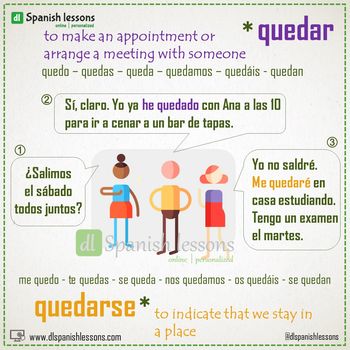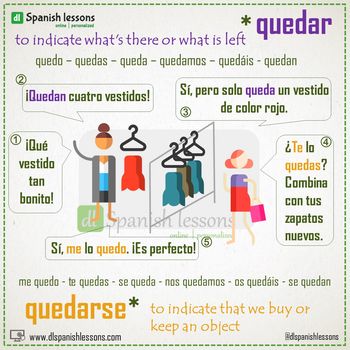✎ Video lesson + interactive exercises (see below)
Spanish students often get confused when they have to use the verbs “quedar” and “quedarse”. In this blog entry, I’m going to explain some main uses of both verbs in the most precise way possible. Additional examples are going to help you to use them correctly.
How to conjugate those verbs?
First, we’re going to have a look at the conjugation of each of them:
The conjugation of quedar in simple present indicative is as follows:
- Yo quedo
- Tú quedas
- Él/ella queda
- Nosotros/as quedamos
- Vosotros/as quedáis
- Ellos/as quedan
The verb quedarse has a reflexive pronoun. The conjugation is as follows:
- Yo me quedo
- Tú te quedas
- Él/ella se queda
- Nosotros/as nos quedamos
- Vosotros/as os quedáis
- Ellos/as se quedan
What uses do these verbs have?
Let’s have a look at some common applications for each of them.

A) We’ll begin with quedar:
➷ to make an appointment or arrange a meeting with someone
✎¿Quedamos para ir a cenar? (Shall we meet for dinner?) ✎He quedado con mis amigos para ir a cenar (I made an appointment with my friends to go out for dinner)
➷ to indicate what’s there or what is left, as well in relation to time.
✎¿Queda pan? No, no queda nada. Hay que ir a comprar. (Do we have bread left? No, there's nothing left. We have to go shopping.) ✎¿Queda mucho para que termine la peli? No, solo quedan 10 minutos. (Does it take long for the movie to finish? No, there are just 10 minutes left.)
➷ to indicate the result of an action or situation.
✎Tu manualidad ha quedado muy bonita. (Your handicraft turned out really pretty.) ✎¿Cómo ha quedado la nueva cocina? (How do you think did the new kitchen turn out?)
➷ to indicate how a piece of clothing suits us.
✎¿Cómo te queda el vestido? (How does the dress suit you?) ✎Me queda muy bien. (It suits me really well.)
Attention: The last use where we indicate how a piece of clothing suits us confuses quite a lot of students. Why? Well, here we use indirect object pronouns (me, te, le, nos, os, les). Since some of them coincide with reflexive pronouns (me, te, se, nos, os, se), students usually get quite mixed up.
B) We continue now with the uses of quedarse:
➷ We use it to indicate that we stay in a place.
✎Yo no voy a salir. Me quedo en casa para estudiar. (Today I'm not going to go out. I'll stay home to study.) ✎¿Queréis quedaros a tomar un café? (Do you want to stay for a coffee?)
Attention! Here you can see that the pronoun can stand before the verb (me quedo) or after as well as together with it (quedaros).
➷ We use them to indicate that we buy or keep an object.

✎Me encanta esta falda. ¡Me la quedo! ¿Qué precio tiene? (I love the skirt. I'll keep it. How much is it?) ✎No necesito este libro. ¿Te lo quieres quedar? (I don't need this book. Do you want to keep it?)
➷ It can also be used to indicate change or a reaction. It can be in regard to a situation or a state (physical or emotional).
✎Anoche me quedé dormido viendo la película. Estaba muy cansado. (Last night I fell asleep watching a movie. I was very tired.) ✎Me quedé sorprendida al ver la nota de mi examen. Pensé que me había salido mucho mejor. (I was surprised when I saw the grade of my exam. I thought it went better.)
I hope this short explanation helps you to use these to verbs better. If you want to practice a bit more, you’ll find some interactive exercises below.
VIDEO LESSON
Practice now with these exercises:
Credits:
Featured image: dl Spanish lessons
Picture 01 y 02: dl Spanish lessons
